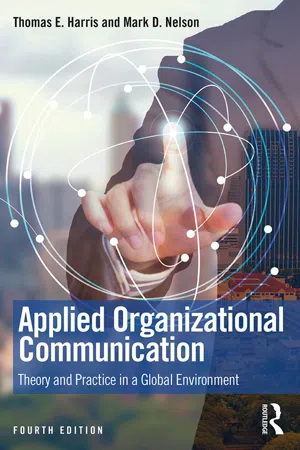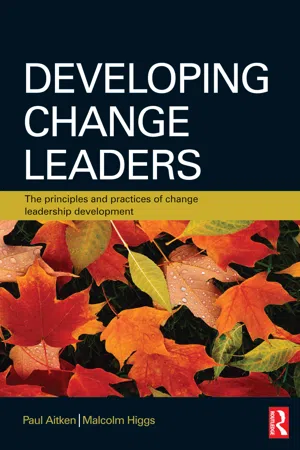Business
Leadership
Leadership in business refers to the ability of an individual to guide, inspire, and influence a team or organization towards achieving common goals. Effective leadership involves setting a clear vision, motivating others, making strategic decisions, and fostering a positive and productive work environment. Good leaders also demonstrate strong communication, problem-solving, and decision-making skills.
Written by Perlego with AI-assistance
Related key terms
12 Key excerpts on "Leadership"
- eBook - ePub
The Human Touch
Personal skills for professional success
- Philippa Thomas, Debra Paul, James Cadle(Authors)
- 2012(Publication Date)
- BCS, The Chartered Institute for IT(Publisher)
Although truly great leaders appear to be wholly superior from birth, the truth is that the major competencies of Leadership can be learned. It is difficult, but there is no learning without mistakes and it is a skill that can always be improved.Myth 2 – Leadership exists only at the top of an organisationThis is a difficult one to shake off, partly because much of the popular literature on Leadership is written by captains of industry. But any group of people wanting to achieve anything has need of a leader and, because most modern organisations are creating small entrepreneurial units and high performing teams, the opportunities for Leadership at all levels are growing.So what, then, isLeadership? Unhelpfully, a unified definition does not appear to exist, but well-known business thinkers have come up with the following statements that shed light on the different aspects of Leadership:‘The only definition of a leader is someone who has followers .’ Hesselbein et al . (1997).‘Leadership is influence – nothing more, nothing less.’ John C. Maxwell (2007). ‘Leadership is the capacity to translate vision into reality.’ Warren G. Bennis (1988).Considering these three views, we can surmise that Leadership is the ability to set goals and deliver strategy by persuading and influencing others to follow your direction. But there is one critical component missing. Dwight D. Eisenhower is popularly quoted as saying that ‘Leadership is the art of getting someone else to do something you want done because he wants to do it’.8 In other words, Leadership is:Getting things done by getting others to do things willingly .Exactly how you go about achieving this in practice, what skills, attributes, values and behaviours you need to possess to be an effective leader of people, is the subject of much debate. From Jack Welch to Field Marshal Montgomery, there are as many approaches to Leadership as there are leaders. Much work has been done both in the field of psychology and management sciences to group and simplify the common themes in these approaches. Understanding the main Leadership ‘styles’ can help those of us who are looking to develop our skills as leaders, by identifying the approach that will work best or feel most comfortable for us as individuals, whether we’re managing a small virtual team in a project or running a large, information technology (IT) function. - eBook - ePub
LIS Career Sourcebook
Managing and Maximizing Every Step of Your Career
- G. Kim Dority(Author)
- 2012(Publication Date)
- Libraries Unlimited(Publisher)
9Leading
Chapter Highlights• Definition of Leadership• Becoming a Leader—The Outside Perspective• Becoming a Leader—The LIS Perspective• Gender/Gen-Y Frames and LeadershipWho would have thought that when William Shakespeare wrote in Twelfth Night “Be not afraid of greatness: some are born great, some achieve greatness, and some have greatness thrust upon them,” we would still be trying to understand how greatness—that is, Leadership—could be taught to those in the latter two categories?Or when American political pamphleteer Thomas Paine uttered that famous directive (and popular bumper sticker) “Lead, follow, or get out of the way,” that over 200 years later, individuals, groups, and organizations would still be wrestling with how to most effective identify and achieve their goals?For one has only to have worked for a brief amount of time in any organization to realize that Leadership is an art not easily mastered, but one whose effective performance is critical not only to the success of the organization but also to the well-being of those who work there.Definition of Leadership
What is Leadership? As defined by Business: The Ultimate Resource , Leadership is “the capacity to establish direction and to influence and align others toward a common goal, motivating and committing them to action and making them responsible for their performance.” This concise and clear definition certainly captures the main points, but also substantially underplays the astounding complexity of challenges facing leaders in all organizations today.However, it does have the major advantage of not constraining Leadership roles to those who head up organizations, but instead allows for Leadership activities to be undertaken throughout the organization, by anyone. In today’s transitioning libraries and organizations (transitioning to what, none of us are sure at this point), the ability to instill some aspects of Leadership, including self-Leadership, among employees may be one of the most important tasks of the organization’s recognized leader, whether that be director, dean, or chief executive officer (CEO). - eBook - ePub
Applied Organizational Communication
Theory and Practice in a Global Environment
- Thomas E. Harris, Mark D. Nelson(Authors)
- 2018(Publication Date)
- Routledge(Publisher)
For most of us, these two exercises raise as many questions as they answer. Leadership is a process whereby an individual influences a group of individuals to achieve a common goal. Practically every perspective provides part of the picture on Leadership in organizations. Like democracy, goodness, or other terms we all use frequently, Leadership is a concept best defined by examining its seven general characteristics.Leadership CharacteristicsSeven concepts – vision, willing followers, influence, emotional intelligence, information seeking, situational adaptability, and communication – appear in the majority of Leadership examinations. We offer these not as a complete picture, but as the underpinnings of effective Leadership.First, leaders forward avisionthat clarifies direction, provides meaning, and motivates followers.A strong determination to achieve a goal or realize a vision – a conviction, even a passion is important. This sense of direction provides meaning. More and more organizations and their people are in a crisis of meaning. Those who would aspire to Leadership roles in this new environment must not underestimate the depth of this human need for meaning. Getting people to commit to common values and objectives within an organization is the foundation of corporate culture.Second, leaders havewilling followers. This places the relationship between leaders and followers as the pivotal issue. Leadership is interpersonal more than it is personal and is used to create the interacting ebb and flow between leader and follower. This relationship will be further developed when we examine emotional intelligence below. Leadership clearly depends on responsive followers in a process involving the direction and maintenance of collective activity. Leadership is more likely to occur in groups, but it is equally important in interpersonal contexts.A third major attribute isinfluence. - Konstantinos Biginas, Stavros Sindakis, Antonia Koumproglou, Vlasios Sarantinos, Peter Wyer, Konstantinos Biginas, Stavros Sindakis, Antonia Koumproglou, Vlasios Sarantinos, Peter Wyer, Konstantinos Biginas, Stavros Sindakis, Antonia Koumproglou, Vlasios Sarantinos, Peter Wyer(Authors)
- 2022(Publication Date)
- Emerald Publishing Limited(Publisher)
As emphasised throughout the chapter, the role of Leadership is vital to the performance and survival of small businesses. The style leaders adopt will determine how effective they have been in guiding the organisation to be successful (Ireland & Hitt, 2005). Individuals from different cultures also have a different understanding of what effective Leadership is. It is important that leaders understand the differences in expectations from their employees and adopt an appropriate style of Leadership. Effective leaders are important to any type of organisation as they will be able to influence employees in the right direction, equip them to achieve the vision and mission and encourage them to be committed to the values and philosophy of the business. Effective leaders have the ability to unite the employees to work towards achieving the goals of the organisation which is critical to its success and performance (Stahl, 2007). Great leaders are good at communicating effectively the future direction of the business to employees and are capable of getting them to work together to achieve the desired goals (Buckingham, 2005b). For Plowman, Solansky, Beck, and Lakami (2007), effective leaders are also good at solving problems, guiding the organisation through turbulent times and succeed in achieving more from the employees. Ireland and Hitt (2005) and Stahl (2007) further reiterate our emphasis that organisational performance or success is influenced by differences in the style of Leadership. Leaders are an integral part of small businesses’ environment and play an important role in influencing the performance of both the organisation and individual employees- eBook - ePub
Rethinking Leadership
A Critique of Contemporary Theories
- Annabel Beerel(Author)
- 2021(Publication Date)
- Routledge(Publisher)
(Raelin, 2003, pp. 6–7) “Leadership is a process by which leaders and followers develop a relationship and work together toward a goal (or goals) within an environmental context shaped by cultural values and norms”. (McManus and Perruci, 2015) “I define a leader as a anyone who takes responsibility for finding the potential in people and processes, and who has the courage to develop that potential”. (Brown, 2018, p. 4) The lack of goal setting and the ambiguity of many of the goals set must account for some of the failures so evident in leaders today.Critical Leadership questions
- Are there specific circumstances that require the activity of Leadership?
- Is there something about the person and his or her actions that makes an event or experience one that qualifies as exercising Leadership?
- Does the person need to exhibit any certain style of behavior that will qualify as an act of Leadership?
- Do followers have to respond in any special way to illustrate they are following a leader?
- Are the leaders responsible for setting the goal or direction of the group? Or is the person who sets the direction of the group the leader?
- Does the goal to which the followers are directed have to be a worthwhile or an ethical one to make it an act of Leadership (Beerel, 2009, p. 65)?
How context affects Leadership
Independent of style or type of Leadership, context plays an ever-more-important role in the efficacy of Leadership.If we recall Kurt Lewin in Chapter 3 , human behavior is always the result of the individual encounter with the environment. The two are interdependent. They co-create situations in which they influence one another. A person is dependent on the context. Context influences behavior.Lewin referred to the environment as the field, and he said this field is always changing. In this field, there are always many variables and forces at play. Leaders need to understand this dynamic, and they need to be able to read the environment as well as possible. They also need to know that their actions are influenced by the situation in a manner that is outside their conscious control. - Pamela McCauley(Author)
- 2017(Publication Date)
- CRC Press(Publisher)
chapter three Leadership within an organizationTo be effective as a leader, it is important to understand how to add value in support of the vision and mission of an organization. Thus, an individual must gain some knowledge of organizational Leadership within the environment, the specific organizational culture, and finally the organizational structure.Understanding organizational LeadershipPart of being able to correctly lead within an organization depends on understanding the functioning of the particular organization. Organizations are far more dynamic than they once were; people no longer stay at the same company for their entire careers. It is essential to quickly adapt to and understand the needs of your organization in order for both you and it to grow. Thus, it is even more important that a clear perspective be gained early in one’s tenure at an organization. Generally, individual leaders are established throughout organizations to support the overall organizational objectives and goals. According to Zaccaro and Klimoski [1 ], the primary areas of organizational Leadership that have some degree of consensus in the literature can be narrowed down to four principles. These broad principles include the following:1. Organizational Leadership Involves Processes and Proximal Outcomes (such as Worker Commitment) that Contribute to the Development and Achievement of Organizational PurposeLeadership positions are setup in the work place to enable organizational subunits to achieve the reasons for their existence within the larger system. The purpose of an Organizational Leadership is to set a direction for collective actions. The process of Leadership is aimed at defining, identifying, establishing, or translating organizational directions for their followers and aiding or enabling the organizational processes that should result in the accomplishment of this function. Organizational purpose and direction is described in several ways, including through mission, vision, strategy, goals, plans, and tasks. The operation of Leadership is inextricably tied to the constant growth and accomplishment of these organizational goals.- eBook - ePub
Leadership Solutions
The Pathway to Bridge the Leadership Gap
- David S. Weiss, Vince Molinaro, Liane Davey(Authors)
- 2010(Publication Date)
- Jossey-Bass(Publisher)
Organizational Leadership capacity: Each business has various products and/or services that need to flow through its organization to deliver value to its external customers or stakeholders. An organization needs to develop processes and tools to increase the effectiveness of how its Leadership works with these products and/ or services. These processes and tools are the “machinery” of Leadership capacity.• Individual Leadership capacity: The organization requires a current and future cadre of leaders who are trained, capable and willing to make effective business decisions and to lead people to optimize the available organizational capacity. These capable and willing people create the “human side” of Leadership capacity. Leadership capacity is enhanced by the following:ο Leaders who are fully engaged and aligned to the core purpose and vision of the business.ο Organizational practices and programs that help make individual leaders more effective. Some examples of these programs include: well-designed recruiting and selection profiles, orientation and development programs, cross-functional planning exercises, coaching and mentoring.The organization’s Leadership culture creates and embeds expectations that further reinforce a more effective type of Leadership. Organizations need to ensure they have the level of Leadership capacity required to execute their strategies. Talented individual leaders, supported by effective organizational practices, in a reinforcing Leadership culture, are able to propel businesses to achieve their strategic goals. In contrast, organizations with insufficient Leadership capacity to meet their business needs are unable to drive the alignment and engagement of employees to the strategic direction, which can put the entire business at risk.All organizations should determine the level of Leadership capacity they require to propel their business forward. Unless they achieve that level, the resulting gap in Leadership capacity will very likely cause a significant erosion of their business. Some organizations are attempting to build a level of Leadership capacity beyond the minimum requirements. These organizations realize they may need to have back-up Leadership resources available for various reasons—perhaps their leaders may choose not to take on certain roles or they won’t live up to their expectations, or they may choose to leave the organization. - eBook - ePub
Set them up for success
A practical approach to managing your team
- Ernest Mhande, services Reality Premedia, Nicholas Challis(Authors)
- 2016(Publication Date)
- Ernest Mhande(Publisher)
6. Leadership – UNDERSTANDING THE MAIN Leadership STYLES6.1. WHAT DOES THE TERM “LEADER” MEAN?
Since the beginning of time, “thinkers”, psychologist and behavioral theorist have been grappling with defining “Leadership”. As far back as 1982 Linda Smircich and Gareth Morgan defined Leadership as follows:“Leadership is realized when one or more individuals succeed in attempting to frame and define the reality of others.”Few would argue with this definition. There is truth in it. But is this the whole truth? Is there something more to Leadership? We have heard of leaders who have been described as “dictators”, others as “oppressors”, some as “tyrants”, and on the other extreme we have heard of some described as “useless”, “toothless”, “weak-kneed” and “incompetent”.Formative AssessmentGroup activity:In your groups discuss and agree on a definition of Leadership, which you believe is the most applicable today’s leaders in Asia and the Pacific.Some leaders spend little time pondering over their Leadership style. They act spontaneously, doing whatever they ‘think’ or feel is ‘best’. This works for some who have natural instincts of Leadership, but for the majority Leadership does not come as naturally, and we need to learn many skills, and make many behavioral adaptations in order to be truly successful leaders. Can one learn to become a successful leader? Absolutely – and thank goodness for that. In the complexities of the modern world, we desperately need great leaders – in so many walks of life!What is a successful leader? How would one describe such a person? Well, most definitions on the subject define a leader as a person who influences others. In the context of this program, a possible definition of Leadership could be:“The ability and actions of an individual or group to influence and mobilize stakeholders to achieve desired results.”6.2. THE QUALITIES OF EFFECTIVE Leadership
- eBook - ePub
- Gopal K. Kanji(Author)
- 2012(Publication Date)
- Routledge(Publisher)
p. 4 ) conducted an exhaustive literature review on the matter and found five representative definitions of the concept:• Interpersonal influence directed through communication, towards goal achievement • The influential increment over and above mechanical compliance with directions • An act that causes others to act or respond in a shared direction • The art of influencing people by persuasion • The principal dynamic force that motivates and coordinates the organization in the accomplishment of its objectives. From the proposed definitions, it may be easily argued that Leadership inevitably comprises an influential component. After this review, Du Brin adopted the view that Leadership is the ability to inspire confidence and support among people who are needed to achieve organizational goals.Northouse (1997: 3) defines Leadership as ‘a process whereby an individual influences a group of individuals to achieve a common goal’ and emphasizes that viewing Leadership as a process has the advantage of focusing attention on the transactional and interactive event that occurs between the leader and his/her followers.If traditionally the study of Leadership was clearly focused on the study of the leader, recently there has been growing evidence that Leadership does not exist separate to follower perceptions (Andrews and Field 1998).This reality is reflected in the way Bass (1990, cited in Andrews and Field 1998) sees Leadership as ‘an interaction between two or more members of a group that often involves a structuring and restructuring of the situations and the perceptions and expectations of the members’.The way followers regard their leaders will depend upon the Leadership prototypes that they will have in mind. Lord (1985, cited in Andrews and Field 1998) presented a model in which Leadership perceptions derive from two processes: recognition (identification of traits and behaviours in conformance to existing notions of Leadership) and inference (based on particular outcomes). - eBook - ePub
- Gary Rees, Raymond French, Gary Rees, Raymond French(Authors)
- 2016(Publication Date)
- CIPD - Kogan Page(Publisher)
HR professionals will be concerned to ensure good Leadership in their organisations, to improve both the performance of the organisation itself and to enable it to attract and keep good staff. This means choosing appropriate frameworks for the selection of potential leaders, their initial training, managing the performance expected of them once in the job, appraising, developing and rewarding them, facilitating their careers and, sometimes, removing them. A coherent, fair and equitable approach to these tasks is thus essential.KEY LEARNING POINTS
- The relationship between Leadership and management is a close one.
- The way in which we analyse and understand Leadership has important implications for personnel professionals, particularly with respect to the selection and training of organisational leaders.
- An over-emphasis on charismatic Leadership can result in undesirable organisational outcomes.
- Understanding Leadership is not just about a leader-centric approach; there are other Leadership theories emerging which consider Leadership from relational and process perspectives.
- Leadership development takes the lion’s share of most organisational training budgets, but with limited evidence of effectiveness.
- Improving leader and Leadership development requires better needs analysis, and clarity of what is being developed and for whom, alongside robust evaluation.
CASE STUDY 5.4
LEARNING TO LEAD IN SOUTHSHIRE SCHOOLS
Anil Gupta and Sandra Carter have recently been promoted to the headships of two primary schools in Southshire. Leadership in modern schools is especially challenging as it requires high-level technical skills combined with well-developed relationship skills.As part of the trend to free schools from local authority control and grant them more autonomy, head teachers have had to learn a range of new technical skills including project management, HRM, financial and budgetary management, public relations skills and political sensitivity.They need to be respected leaders of staff and pupils alike, and whilst they have scope to shape the strategic direction of their school, the increased autonomy has been accompanied by greater scrutiny and accountability. - eBook - ePub
- Simon Robinson, Paul Dowson(Authors)
- 2012(Publication Date)
- CIPD - Kogan Page(Publisher)
The trait theory assumes a one-size-fits-all-shapes-and-contexts Leadership model. None of this shows any evidence of critical reflection about diversity of Leadership. A good example is the UK National Health Service (NHS), which has developed a competencies framework (Western, 2008). The framework underlines the idea of Leadership as essentially individualist, pointing to generic competencies that are associated with success. However, it is not clear that a generic model can fit the many different professional groupings in the NHS. The very different contextual differences between the leader of a surgical unit, a charge nurse on a busy accident and emergency ward, and a chief finance officer have to be considered. Western argues that the descriptions of leaders can easily become so open-ended as to be of little practical use. Perhaps even more striking is the point that Leadership in such a context has to relate to a plurality of professions. Any leader may find that a leader from another profession is either in authority above them or that he or she may have to work with other leaders who are on the same level and who have different focuses. The same applies to any business, where different professions, from accountancy to engineering, may have different perspectives about vision, values and objectives. Leadership in this view is part of interactional relationships, not something above them. This becomes critical when we come to governance, with strong arguments for the importance of dispersed Leadership and the need for different perspectives.All of this suggests that ethics should be at the heart of Leadership (Ciulla, 2004), the leader shaping ethical awareness with the firm. None of this says that the great man theory and related ideas are totally wrong. On the contrary, this theory and its associated emphasis on individual Leadership may prove important in context.But how should the leader deal with such value and purpose? Two theories argue for the importance of Leadership that develops the ethical tone of the organisation and the ethical capacities of its members: transformational Leadership and servant Leadership.transformational Leadership
The founding advocate of this approach was James Burns (1978), with later developments by writers such as Bass (2005). Burns argued for a view of the leader as essentially moral. Figures such as Hitler, by definition, fall outside Leadership discourse. Burns attempts to establish that the purpose of the leader is by definition transformational, enabling the organisation to change and respond to change. He distinguishes transformational Leadership from transactional Leadership - eBook - ePub
- Paul Aitken, Malcolm Higgs(Authors)
- 2010(Publication Date)
- Routledge(Publisher)
Many examples of effective Leadership, from the business world, began to lose credibility when ‘successful’ CEOs left an organization only to see a significant dip in performance. This, in part, led to a view about the purpose of Leadership being concerned with the delivery of sustainable performance. This view, which began to emerge in the late 1980s, positioned the purpose of Leadership as being the development of capability. Building individual and organizational capability is seen as central to the delivery of sustainable organizational performance. Today, the thinking about the purpose of Leadership is more concerned with an integration of the above three views. This viewpoint sees Leadership as enabling results to be delivered through the development of capability; importantly, the capability to effect change, transformation and sustainability.- The focus of Leadership studies
The focus of Leadership studies has shifted notably over the period we are considering. This shift has occurred in two ways. First, our approach to Leadership studies has begun to move away from a focus on top leaders, which has traditionally dominated research in this area, to a more distributed view of Leadership within an organization. This Leadership has moved from being purely associated with position within an organization to being seen to be concerned with the process by which anyone who needs to engage followers in the organization achieves such engagement. In part, this shift responds to the critique that Leadership studies have been in essence little more than studies of the traits and behaviors of white, male American CEOs (Alimo-Metcalfe, 1995 ). In seeing Leadership as more widely distributed within the organization, we are now able to move from a constant focus on ‘distant’ leaders to exploring the behaviors and practices of ‘near’ leaders.The second shift we have seen under this heading is a move from seeing Leadership as an individually centered phenomenon to being more of a collective activity. Hence, Leadership is now being seen by many as a team game.
Index pages curate the most relevant extracts from our library of academic textbooks. They’ve been created using an in-house natural language model (NLM), each adding context and meaning to key research topics.











